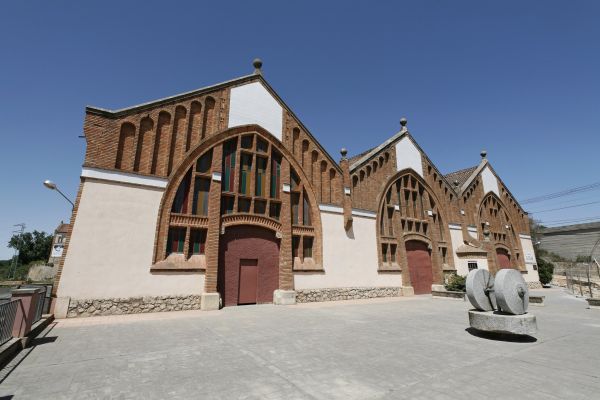There are a
large number of Modernista cellars in the districts of
Conca de Barberà and Alt Camp, the work of architects such as
Cèsar Martinell and
Pere Domènech i Roure. This route will take you to three veritable
wine cathedrals, all of which are included in the
list of 150 places, drawn up by the Catalan Museum of Science and Technology (mNACTEC) and considered to be of
supreme importance as part of Catalonia's industrial heritage.
THE ESPLUGA DE FRANCOLÍ WINE CELLAR COOPERATIVE AND THE WINE MUSEUMYou could
start this route with a visit to the majestic
wine cellar corporative in Espluga de Francolí, one of the
first examples of
Modernista wine cellars in Catalonia. It was designed by Lluís Domènech i Montaner and carried out by his son
Pere Domènech i Roure in 1913. The building consists of
three isles and has a beautiful decorated facade which has recently been restored, along with the buttresses and the interior columns and arcades. The building is now home to the
Wine Museum.
THE BARBERÀ DE LA CONCA WINE CELLAR COOPERATIVEA 15-minute drive will take you to the
Barberà de la Conca wine cellar cooperative which was built between
1920 and 1921 by the architect
Cèsar Martinell. All the structural elements such as the pillars and arches were built from bricks, laid in various ways to produce an extremely beautiful overall effect. The design of the wine presses was also very innovative for the time. The cava produced in the cellars can be purchased in the
shop.
THE ROCAFORT DE QUERALT WINE CELLAR COOPERATIVEA car journey of just another
15 minutes will take you to the
Rocafort de Queralt wine cellar cooperative, designed by
Cèsar Martinell in 1918, just a couple of years before the Barbera de la Conca wine cellar corporative. Inside, Martinell employed a construction technique he had learned from Gaudí that involved the use of parabolic arches and thus was able to achieve the perspectives and diaphanous spaces that are a characteristic of his agricultural buildings.
You could take advantage of your visit to
savour some of the delights of the local cuisine, such as the Conca de Barberà's renowned
coques de recapte (a pastry-based savory dish with roasted peppers and aubergines that might also include other ingredients such as sardines, herrings or sausage), the cured meats and, of course the
D.O. wines and cavas.
Have we managed to inspire you? If you have any other interesting suggestions please send them to us on Facebook or publish your photos on Instagram with the hashtag #patrimonicultural 